Just through from Audi now is official confirmation that the RS5 will debut at Geneva as expected. Following the leaked images of the RS5 over the weekend Audi has also confirmed the car’s basic specs, which are pretty much as reported last week.
Powered by a naturally aspirated high rev 4.2-litre V8 FSI, the RS5 will have peak power of 331kW (450PS) at 8250rpm, with maximum torque of 430Nm available from 4000-6000rpm. Coupled with a specially reinforced 7-speed S tronic transmission the RS5 is able to accelerate to 100km/h in 4.6 seconds. Not bad for a car tipping the scales at more than 1725kg. This is the first of Audi’s RS models to be fitted with the double clutch technology and, at this stage, there is no word on a manual gearbox option.
The engine is derived from the acclaimed B7 RS4 model, but advancements to the engine management, intake and exhaust have enabled Audi engineers to find more power and torque, while at the same time improving overall efficiency. Highlighted by the claimed average fuel consumption of just 10.8l/100km. That’s impressive.
Also getting a once over is the car’s quattro all-wheel drive system. Now fitted with a self-locking crown-gear differential, up to 70% of available torque can be sent to the front wheels, or up to 85% to the rear. In normal conditions the torque is split 40:60, front to rear.
Riding on either 19″ or optional 20″ alloy wheels the RS5 is fitted with 265/35 tyres as standard. To ensure the RS5 can stop effectively 365mm vented discs can be found up front, with the option of 380mm ceramic carbon discs, as well.
After driving the V8 powered S5 last year, I was left feeling like the car was more lazy cruiser than ball tearing coupe. The added power of the RS5 is one thing, but have Audi been able to give the overall driving experience a bit of a nudge as well? Something a car like this both demands and deserves. I’ve heard one unsubstantiated rumour about the RS5’s exploits around the Nürburgring Nordschleife (sub 8 minutes), and if that proves correct it would seem Audi have got it right. For reference, the E92 BMW M3’s best unofficial time stands at 8:05 as tested by Horst von Saurma from German publication Sport Auto.
Other points of interest include an ESP system that can be completely disabled if required. A rear wing, usually hidden in the boot lid, will raise automatically at speeds over 120km/h, it will retract again once speed is below 80km/h. The underbody of the RS5 has been designed to aid downforce, while also providing optimum cooling benefits to the brakes and S tronic gearbox.
Usual Audi RS styling tweaks, such as flared wheel guards and twin oval exhaust tips are also seen on the RS5, as most readers will already be aware.
The RS5 will go on sale in Europe in a few weeks, with a starting price of around €77,700 (AU$117,500). Sadly, you can bet the RS5 will cost a lot more than that when it makes it to Australian shores before the end of 2010.
The full press release from Audi can be read below and six more new pics are also available in 2000px super image sizing.
Audi to present the RS 5 in Geneva
- Coupé with 331 kW (450 PS) high-revving V8 engine
- RS 5 also efficient – 10.8 liters per 100 km (21.78 US mpg)
- Newly-developed center differential for quattro drivetrain
Unbridled power lurking in a classically elegant coupé: the Audi RS 5 will debut at the Geneva Auto Show. The high-revving 4.2-liter V8 with its 331 kW (450 hp) unleashes powerful performance while achieving remarkable fuel economy. The seven-speed S tronic and an innovative center differential in the quattro drivetrain transmit power to all four wheels.
Developed by quattro GmbH, the RS models comprise the dynamic spearhead of Audi‘s model range. The RS 5 is the latest torchbearer in a tradition dating back over 15 years to the RS 2 Avant: superior handling in the mid-size class.
A close relative of the V10 which powers the high-performance R8 sports car, the high-revving V8 engine delivers its output from a displacement of 4,163 cm3. Like nearly every Audi gasoline engine, this one also operates via direct fuel injection known by the abbreviation FSI. This same technology has propelled the Audi R8 racing car to four triumphs at the classic endurance race in Le Mans. The common-rail system generates up to 120 bars of pressure.
Intensive fine-tuning of the dual-branch intake and exhaust system allows the undersquare engine to breathe freely; four adjustable camshafts and tumble flaps in the intake manifold facilitate mixture formation. The 4.2 FSI provides imposing torque and is right at home even at high revs – almost like a race engine. The engine delivers 331 kW (450 hp) at 8,250 rpm and – between 4,000 and 6,000 rpm – transmits a maximum of 430 Nm (317.15 lb-ft) of torque.
The vigorous strength, the spontaneous responsiveness, the joyful high-revving, and the throaty, sonorous music: this V8 produced by hand at Audi stunningly combines the essence of power and emotion. The 4.2 FSI propels the coupé’s 1,725 kilograms (3,802.97 pounds) in 4.6 seconds from 0 to 100 km/h (0 to 62.14 mph) to an electronically governed top speed of 250 km/h (155.34 mph). Audi can increase that to 280 km/h (173.98 mph) upon request.
Impressive efficiency: just 10.8 liters of fuel per 100 km
Efficiency is standard in every Audi; the RS 5 is no exception. The ultra-powerful eight-cylinder engine averages 10.8 liters of fuel per 100 kilometers (21.78 miles US mpg) – far less than its main competitors. This impressive figure is due in part to the technologies from the Audi modular efficiency platform. The engine and the entire drivetrain have been optimized to minimize friction, the oil pump operates on demand, and an energy-recovery system conserves energy during coasting and braking.
The standard seven-speed S tronic in the RS 5 – with its high efficiency ratio and its high-geared top speed – also enhances efficiency. It consists of two clutches and two subsidiary transmissions. Both subsidiary transmissions are continuously active, but only one is powered at any given time by the engine. Gears are alternately shifted by the two clutches – at lightning speed, smoothly, and almost imperceptibly.
The seven-speed S tronic, which was specially reinforced to accommodate the high-revving V8, can operate in fully automatic mode – or the driver can shift via the innovative selector lever or shift paddles on the steering wheel. By means of the standard Audi drive select, the driver can switch in automatic mode among three different options: auto, comfort, and dynamic. In the launch control program, the seven-speed S tronic ensures flawless acceleration from a standstill – at full power and with minimal tire slip.
New quattro technology: the crown-gear differential
Like all RS models, the RS 5 also applies its power to the road with quattro permanent all-wheel drive. As for the center differential, which regulates power distribution between the front and rear axles, Audi – the leading all-wheel-drive brand – unveils the next generation: a crown-gear differential.
The self-locking crown-gear center differential is compact and lightweight – and attains a high efficiency ratio.
Thanks to its package of plates, the differential can widely vary the distribution of torque between the front and rear axles. If necessary, up to 70 percent can flow to the front or as much as 85 percent toward the tail end. The 40:60 ratio of the standard rear-biased configuration ensures sporty handling.
This new differential operates in conjunction with electronic torque vectoring, which affects all four wheels. If one of the inside wheels becomes imbalanced while the vehicle is at its operational limits, then the system slightly decelerates the wheel to obviate wheel spin. This results in terrific traction on the one hand while generating a yaw moment which aids cornering.
As a perfect complement to the new quattro drivetrain, Audi can optionally position the sport differential at the rear axle. It actively distributes torque between the rear wheels in order to further boost stability and grip at the vehicle’s limits of handling. The electronic management of the RS 5 sport differential was designed to be uncompromisingly dynamic.
With regard to the springs, shock absorbers, elastokinematics, and the anti-roll bars, the RS 5 chassis exhibits a sporty configuration and renders the body 20 millimeters (0.79 inches) lower than that of the Audi A5. The 19-inch alloy wheels fitted with 265/35 tires are standard. They are executed in an exclusive 5-arm structure design. The RS 5 optionally comes with 20-inch wheels and 275/30 tires. Winter wheels featuring the same dimensions are available; the 19-inch wheel is suitable for snow chains.
The brake system employs powerful and internally ventilated discs, which measure 365 millimeters (14.37 inches) in diameter at the front axle. In order to maximize the dissipation of heat, the steel friction rings are perforated and connected by pins to the aluminum brake discs. The high-gloss black brake calipers bearing RS logos are likewise made of aluminum; the front calipers are fitted with eight pistons each. Audi can optionally fit the front axle with ceramic carbon-fiber brake discs measuring 380 millimeters (14.96 inches) in diameter. They are extremely lightweight, strong, and durable. The electronic stabilization program (ESP) integrates a sport mode and can be switched off entirely.
Even more dynamics: Audi drive select
The speed-dependent servotronic steering in the RS 5 is especially taut. The standard Audi drive select (a vehicle-dynamics control system) allows the driver to switch among three modes of operation – comfort, auto, and dynamic – to adjust steering, the seven-speed S tronic, the sport differential, the engine, and the exhaust system. And if the car is equipped with the MMI navigation system, a fourth mode allows the driver to customize their own profile.
As regards the engine, Audi drive select controls the exhaust system’s two throttle valves and the sound flaps; when they open, the rich sound becomes even more resonant. Along with the sport differential, dynamic steering is another optional component of Audi drive select. Dynamic steering adjusts the steering ratio to a vehicle’s speed – directly for maneuvering at low speeds and indirectly for traveling at highway speeds. At the vehicle’s cornering limits, it automatically ensures smooth handling via minor corrective actions.
The RS 5 exudes an athletic and powerful identity; its classically beautiful coupé styling dazzles with new and clear-cut accents. Its single-frame grille bears a shiny charcoal-gray rhombus-pattern grid. Xenon plus headlights boasting a sweeping strip of LED daytime running lights are standard. The oversized air inlets for the engine, front brakes, and the radiators are bordered by striking contours. The newly designed bumper tapers downward into a splitter.
The flared fenders with the crisp horizontal upper edges are reminiscent of a classic Audi: namely, the all-wheel-drive pioneer Audi quattro, which itself debuted at the Geneva Auto Show 30 years ago. The side sills bear angular caps; the trim strips on the single-frame grille and near the side windows as well as the outside mirrors’ covers feature a matt aluminum look. Eight different paint finishes are available.
The tail end is dominated by two oval exhaust pipes integrated within the bumper. A large diffuser protrudes prominently upward. The spoiler in the tailgate automatically extends at a speed of 120 km/h (74.56 mph) and retracts at 80 km/h (49.71 mph).
The extensively clad underbody of the RS 5 integrates air vents for the seven-speed S tronic and the front brakes. At highway speeds, the aerodynamic characteristics of the RS 5 generate downforce to further enhance stability.
Dynamic elegance: the interior
The vehicle’s dynamically elegant styling extends to the interior. Sports seats with pronounced side sections and integrated head restraints are standard. They are electrically adjustable and feature a leather/Alcantara combination. Alternatives include bucket seats with more prominent contours and folding backrests or ventilated and luxuriously upholstered climate-controlled comfort seats.
The steering wheel has a substantial rim and is covered with perforated leather. The instruments have black gauges and white lettering with distinctive scaling. When the ignition is switched on, the red needles briefly rise high and then drop back down. The driver information system integrates a lap timer for recording circuit times and an oil-temperature gauge. Just like the optional MMI navigation systems’ monitor, it displays an RS greeting upon ignition.
The interior is black and the decorative inlays are made of carbon fiber. A fascia in the instrument panel features a piano finish. The pedals, the footrests, and the optional MMI navigation systems’ control buttons gleam thanks to their aluminum look. Moreover, the door handles consist of two slim strips – typical of Audi RS models. Aluminum inserts adorn the door sill trims and RS 5 logos lend dynamic highlights to the interior.
Upon request, truly exclusive features such as decorative inlays with a dark, stainless-steel mesh look, a black piano finish or brushed aluminum are available. Or seat upholstery featuring special leathers and colors as well as silver headlining. In addition, the Audi exclusive RS program offers options such as suede-covered controls and floor mats bearing RS 5 logos.
A Carbon design package is available for the engine compartment and, for the vehicle body, there are styling packages in black or matt aluminum look. And the acoustically bold Sport exhaust system – also with a sound flap – has black tailpipe trims.
Sales of the Audi RS 5 will begin in the spring. Its basic price will be approximately 77,700 euros.
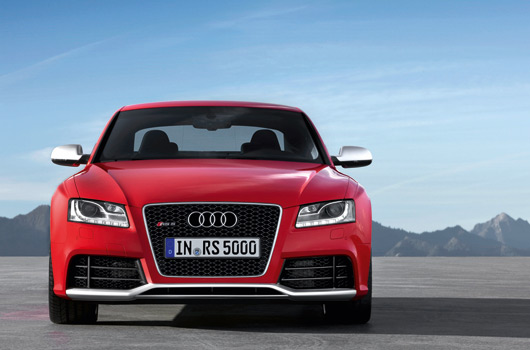
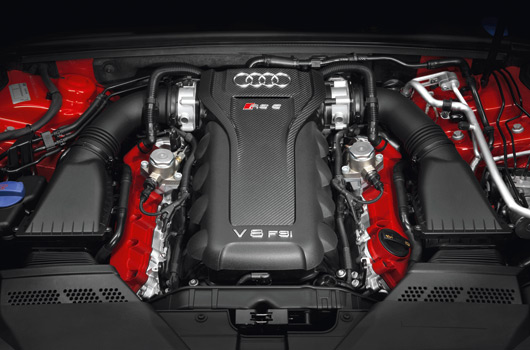
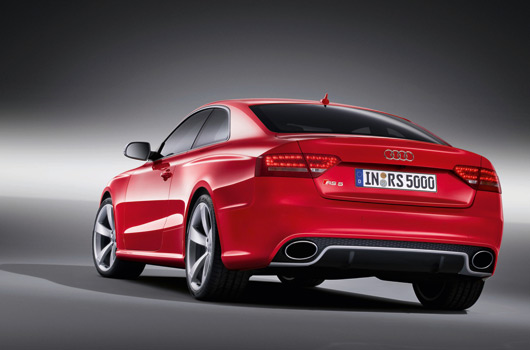
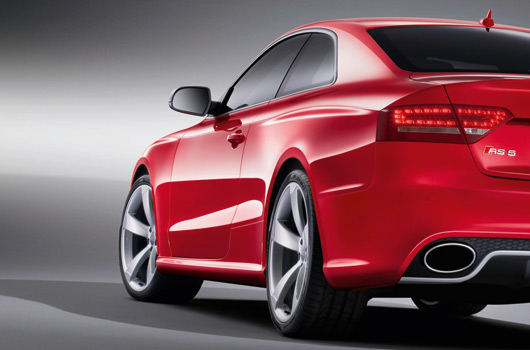
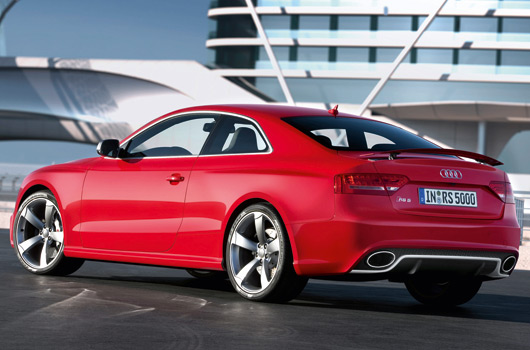
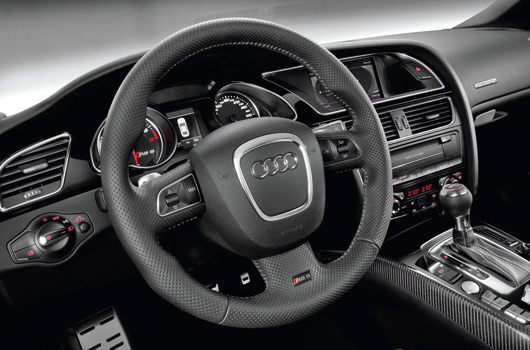
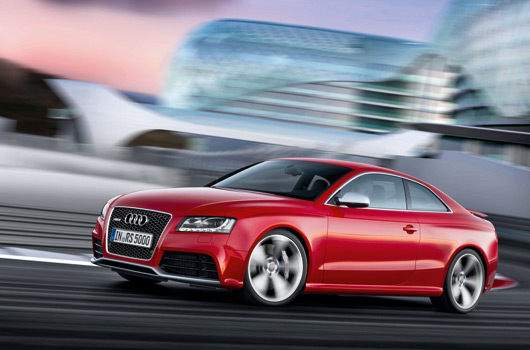
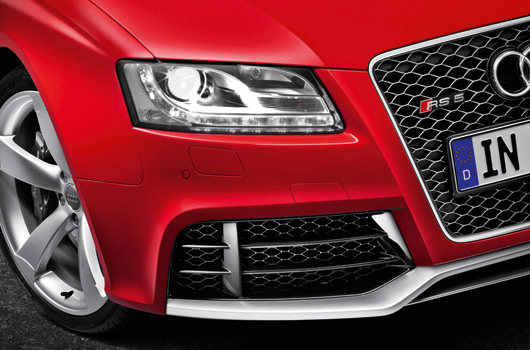
8 replies on “OFFICIAL: Audi RS5 confirmed for Geneva Motor Show”
[…] UPDATE 23 Feb: Official details and images have now been released by Audi. […]
[…] UK have just released details confirming their specs for the RS5 featuring a 450PS 4.2 FSI V8. It’s all as expected and pricing starts at £57,480 OTR (approx AU$96,000). UK deliveries […]
[…] brief video teaser from Audi now, this time featuring the new RS5 coupé. The sound of the 4.2 V8 FSI being driven around an empty racetrack is one well worth listening to. […]
[…] two clips for you after the jump. The clips feature the crown-gear centre differential from the new RS5, as well as explaining torque vectoring, available on the RS5 and also via the sports differential […]
[…] Audi RS5 created waves in the blogosphere when images were “leaked” back in February. Now, Audi […]
[…] is one of the first publications to get their hands on Audi’s new RS5. With a revised 4.2 litre V8 sourced from Ingolstadt’s famed RS4 and a svelte coupé body can […]
[…] international media launch of the Audi RS5 took place a few hours ago and while AUSmotive wasn’t in atendance we can bring you the […]
[…] the 331kW RS5 is deemed to provide enough RS thrills on the current B8 platform (or derivative) of the current […]